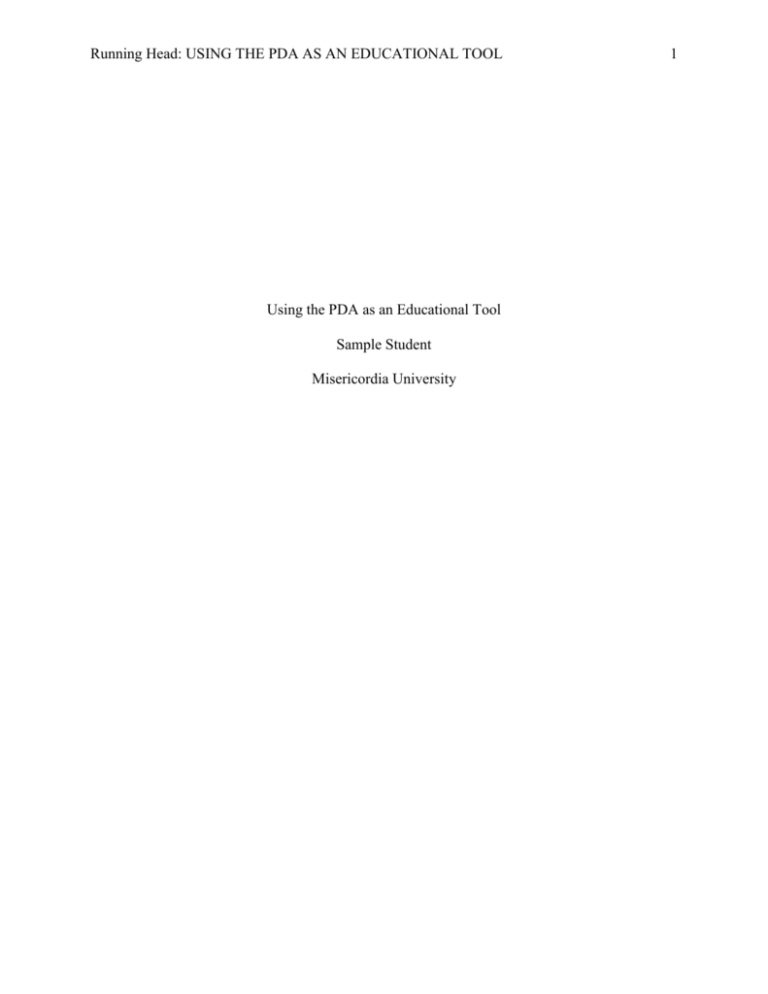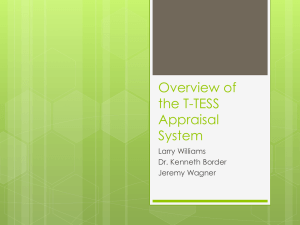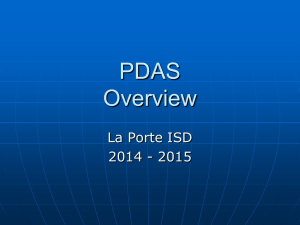APA Sample Paper.
advertisement

Running Head: USING THE PDA AS AN EDUCATIONAL TOOL Using the PDA as an Educational Tool Sample Student Misericordia University 1 USING THE PDA AS AN EDUCATIONAL TOOL Abstract PDAs, personal digital assistants, are tools that can be valuable in the teaching and learning process in the modern classroom. In this paper, the author examines how teachers use PDAs in the modern classroom, the advantages and disadvantages of implementing student use of PDAs in K-12 schools, and why schools should turn to the PDA as a useful educational tool. Keywords: PDA, personal digital assistant, mobile learning 2 USING THE PDA AS AN EDUCATIONAL TOOL 3 Using the PDA as an Educational Tool PDAs are an important topic in education today. The term PDA is an acronym for “personal digital assistant”, which is a popular, handheld form of technology that functions similarly like a computer (Yuen & Yuen, 2003). Teachers are now considering replacing the “typical” classroom computer with PDAs, for they are cheaper, mobile, and rather economical (Galuzska, 2005). If utilized properly, PDAs are advantageous for students and teachers to use inside and outside of schools. In this paper, the author will examine how teachers use PDAs in their classrooms, the advantages and disadvantages of having students possess PDAs in schools, and explain why schools should turn to the PDA as a useful educational tool. The PDA as a Classroom Tool PDAs are extremely efficient, multifunctional tools that would be a perfect investment for busy students and teachers. Yuen and Yuen (2003) state that PDAs can function as a calculator, calendar, textbook, notepad, pencil, and word processor. With PDAs, students can neatly type their notes and have an organized system, instead of losing their important documents. PDAs also function like laptops, but they are smaller and easier to use in classrooms (Lang, 1999). Since PDAs can functions many different ways, students will never find themselves searching to use numerous technological devices. Thus, conserving space can certainly be advantageous in small or cramped classrooms. PDAs enable students and teachers to work and learn together simultaneously, especially with tasks such as writing papers or working together in groups. According to Lang (1999), pupils can perform group projects in the classroom with more accessibility on PDAs than traditionally. Similarly, by using PDAs in schools, an entire classroom of students can revise USING THE PDA AS AN EDUCATIONAL TOOL 4 their papers on their portable devices along with their teacher at the same time (Lang). Since students can quickly fix their papers or essays and store or find them on file, teachers can cover more material in a less amount of time. Studies also show that with PDAs, students are able to communicate easier with their teachers and classmates (Galuszka, 2005). Better and clearer communication is important for a teacher and their classroom full of students. PDAs are also handy for students because they can save, carry, and share their information to with their teachers and classmates. According to Galuszka (2005), PDAs allow students to carry a large amount of information in a small, handheld device. Furthermore, research states (Yuen & Yuen, 2003) that pupils can download and save files onto their PDA, which allows students to bring different files along with them to all of their classes. Therefore, students will find that carrying information with them on a PDA is convenient and helpful. PDAs are a better alternative to traditional computers or laptops. PDAs are small, portable, and turn on and off immediately; rather than like slow, bulky computers (Lang, 1999). They also last longer without running out of power, unlike power-hungry laptops (Cain, 2003). According to Lang, PDAs can last up to three hundred hours on one set of disposable batteries, while laptops can usually last up to eight hours. Therefore, students will not have to waste their time charging or purchasing batteries as often than with a PDA. Thus, since PDAs are less expensive than a laptop or desktop computer for each student, the PDA is the best alternative (Yuen & Yuen, 2003). Overall, PDAs are typically smaller, faster, and more efficient than conventional laptops or computers, which makes the PDA a smart investment for schools. Disadvantages of PDAs in Schools Teachers and schools find that PDAs have a few faults in the classroom. One of schools’ greatest issues with PDAs is that they can cost up to a few hundred dollars each (Galuska, 2005). USING THE PDA AS AN EDUCATIONAL TOOL 5 Despite the fact that a classroom of PDAs is cheaper than buying just a few classroom computers, parents and/or schools may not want to pay the “expensive” price for these wireless devices (Lang, 1999). School districts that do not allocate funds toward purchasing PDAs should understand the pedagogical opportunities that PDAs offer, and purchasing them for the pupils would be a solid investment. Teachers also may dislike PDAs because of their potential to distract learners in the classroom. PDAs contain many different programs which could allow pupils to stray from their studies, such as surfing the web or chatting on Instant Messenger (Cain, 2003). Nonetheless, students do things like these on their cellular phones and other technical devices, and not just on PDAs. Some teachers argue that PDAs do not offer everything that computers do, like a CD-rom drive for instance (Cain). However, PDAs can hook up to their original “parent” computers and open or download files this way. All in all, PDAs can essentially perform the same tasks as a more expensive and immobile computer. Some teachers find user-friendly problems with PDAs. Cain (2003) observes that writing on a small PDA screen with a stylus can be slow and annoying. The small screen and symbols also may be hard to read for some older teachers or students. Also, PDAs are harder for younger students in kindergarten to use because of their undeveloped motor skills (Young, Mullen, & Stuve, 2005). On the other hand, Young et. al., (2005) challenge that children are quickly able to grasp the concept of how to navigate through the PDA, which shows that younger students are adaptable to technology and willing to learn. Advantages of PDAs in Schools PDAs benefit schools economically and conservatively. Young, Mullen, & Stuve (2005) argue that PDAs are a cheaper alternative than computers or laptops in schools. Since schools today strongly encourage the use of computers in classrooms, PDAs certainly could save school USING THE PDA AS AN EDUCATIONAL TOOL 6 districts and taxpayers’ money. Thus, many schools favor PDAs because students can virtually access the same information as a computer (on a PDA), but at a less expensive price. According to Lang (1999), two or three conventional computers cost around as much as thirty PDAs. These handheld devices also do not waste nearly as much paper as a computer. Cain (2003) contends that school districts save money by not wasting library and classroom paper with the use of PDAs. Additionally, PDAs are quite compatible, because they can print their documents with the use of wireless communication. Teachers agree that students enjoy working with PDAs in their classrooms. According to Young et. al., (2005) more than 90% of teachers they polled in K-12 classrooms reported that handhelds are useful in their classrooms. One teacher even declared that “My class actually looks forward to working on their PDAs” (Lang, 1999). It is also more likely for students to participate in their classroom activities with the use of a stimulating handheld device, rather than writing on traditional paper. Teachers also can use PDAs for themselves as a useful organizer for things such as lesson plans and appointment reminders. Conclusion This paper explored the topic of PDAs in classrooms today. In this paper, the author examined how teachers use PDAs in their classrooms, the advantages and disadvantages of having students possess PDAs in schools, and explain why schools should turn to the PDA as a useful educational tool. Research found that PDAs function just as well as regular classroom computers, but PDAs are cheaper, mobile, and wireless. All in all, schools should integrate PDAs into their classroom technology, for it would be a valuable investment. USING THE PDA AS AN EDUCATIONAL TOOL References Cain, M. (2003). PDA: paradigm-disrupting appliance? Journal of Academic Librarianship, 29 (1). Retrieved from Academic Search Premier. Chang, Y. M., Mullen, L., & Stuve, M. (2005). Are PDAs pedagogically feasible for young children? T.H.E. Journal, 32 (8). Retrieved from Academic Search Premier. Galuszka, P. (2005). Technology’s latest wave. Black Issues in Higher Education, 22 (2). Retrieved from Academic Search Premier. Lang, M. (1999). Electronic learning. Write on! Instructor, 108 (8). Retrieved from Academic Search Premier. Yuen, S. C., & Yuen, P. K. (2003). PDAs as educational power tools. Tech Directions, 62 (9). Retrieved from Academic Search Premier. 7








